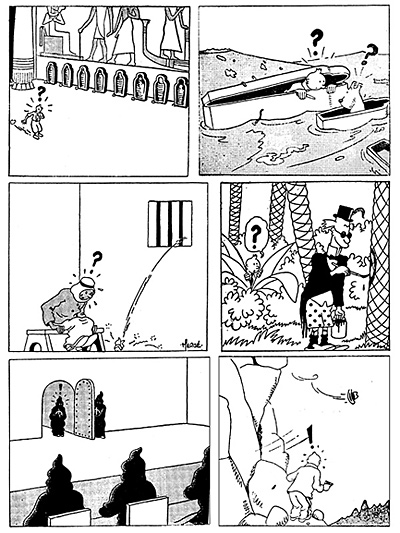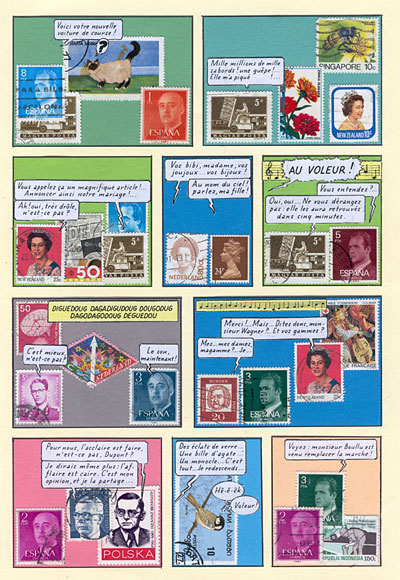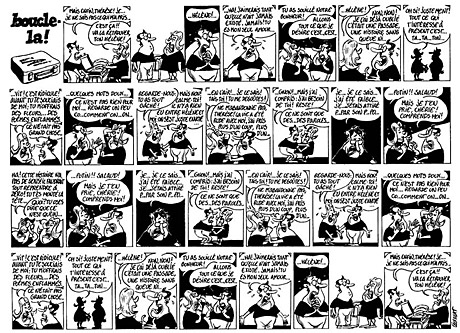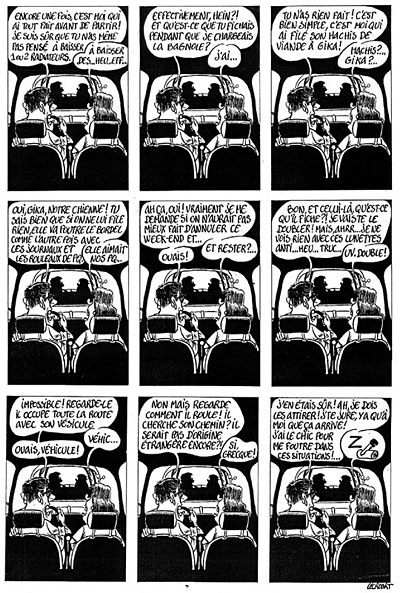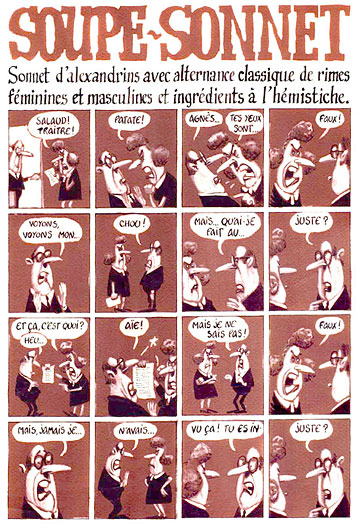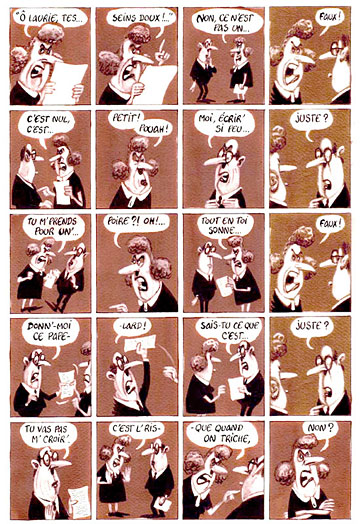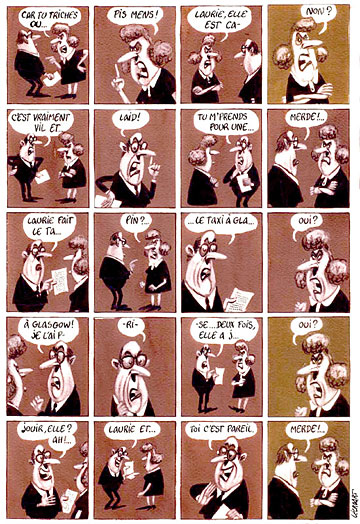(Click on any image below to view a larger version of the image.)
OuBaPo stands for OUvroir de BAnde dessinée POtentielle, or “Workshop for Potential Comics.” Like the OuLiPo, its old brother, the OuBaPo is a group of “artists” who meet regularly to extend their creative endeavors by elaborating and using a variety of self-imposed constraints.
Granted that constraints are specific to each art form, members of the OuBaPo rethink the term constraint on different grounds. For instance, since the basic constituents in comics are the story, the plate, the frame, and the balloon, basic constraints would relate to sequencing and the number of pages, frames, and balloons the artist decides to use to tell a story. Other constraints are more general and include technical effects such as reduction, inversion, and transposition.
GILLES CIMENT
In the example below, Gilles Ciment, a co-founder of the Oubapo, presents a constraint called “reduction.” The challenge is to
distill one of the standard 62-page stories of The Adventures of Tintin to as few as six images. Obviously, to some degree, the appreciation of such reductions relies on the readers knowledge of the source text, in this case Les cigares du pharaon/ The Cigars of the Pharaoh (www.tintinologist.org/guides/books/04cigars.html)
In our recent interview, Ciment noted that he used the first edition of Hergé’s 4th album (1934) because it is more susceptible to reduction since it is less elaborate than the second 1955 edition. This first edition is printed in black & white with more simple drawings. In his “reduction,” Ciment seeks to valorize the “ligne claire” or “clean line,” one of the most distinctive formal characteristics of Hergé’s early albums. In deciding on his method, Ciment specified that he had to respect the order of the images in the narrative and limit his choices to key moments of the story, in order to simultaneously say something new and interesting about the story, the characters, and the author.
The quest for the new is strictly sought by distilling Tintin’s words—relatively ample, compared to some other artistic comic books—to no more that two punctuation marks: ! and ?. These minimal signs remind us that Tintin does not really control much in the story; indeed, he is always surprised or puzzled—a fundamental element of his apparently inexhaustible youth. These exclamations and interrogations remind readers that his adventures are literally “produced” by chance events and that these “events” are organized by Hergé. Ciment is neither a cartoonist nor a scriptwriter and therefore it is only through a manipulation of the existing formal elements (frames, pages, plates, etc.), that he can bring his artistic contribution to the group, helped by his knowledge as a historian, a critic and a theoretician of comic books (see his publications Cinéma et bande dessinée [1990] and L’histoire—par la bande [1993]).
The parodic aspect goes even further in Ciment’s next work, “Les bijoux de la reine “ (The Queen’s Jewels) [see the next 2 plates]. In this case, Ciment retells one of Tintin’s most famous adventures, Les bijoux de la Castafiore (The Castafiore’s Emerald) within another medium, through modes of transposition. Since road signs had already been used to tell a Tintin’s story, Ciment decided to use stamps.
It might first be noticed that Tintin is so famous in Belgium and in Europe that he and his partners were represented several times on stamps. In our interview, Ciment confrimed what is written under the title of the story, that the stamps come from a mixed-package of 300 cheap stamps he bought at the flea market (hence the subtitle: “Timbres issus d’un ‘vrac’ bon marché acheté rue Drouot”). To best appreciate Ciment’s creative slant one has to know that this 21st album (published in 1961-63) is itself a self-parody of Tintin’s previous adventures. In effect, Tintin and his companion, Captain Haddock, are not only globe-trotters, but they are on the move at all times; indeed, their stories are built around the conceit of “perpetual movement.” In this album, the “anti-adventure” takes place in Moulinsar, the castle near Brussels, and the heroes are “stuck” at home because of several unlucky events, such as the arrival of unexpected and undesired guest, a broken leg, and the diegetic interruption of the media and other digressive incidents and accidents—the media plays a key role in the story, but also functions playfully on the formal level, as a mise en abîme of the story’s self-reporting by a fictive Belgian television crew. Ciment’s use of the stamp as medium thus is also ironic because, as he says in
the interview, «the stamp itself is a metaphor for travel around the world.»
Moreover, by using stamps to represent a comic book adventure, Ciment alludes to two key elements of the genre’s culture: first, the stamp also implies the idea of collecting; second, if, in Hergé’s time, comics were not yet recognized as the ninth art, as they are today, they were already the object of extensive speculation, both economic and scholarly. This is certainly something Hergé was conscious of since his last and unfinished album, Alph-art (published only in 1986, three years after his death), is a story that questions the category of art and the act of collecting.
The queen of Ciment’s title, “The Queen’s Jewels,” is «interpreted» by the British queen, Elisabeth through the stamp representing Queen Elizabeth. In Ciment’s story, she actually replaces the Castafiore, an otherwise marginal character of Tintin’s Adventures who became the central character of this album. In Hergé’s albums, the Castafiore is a satire of a diva with all its accompanying clichés: whimsical, tyrannical, etc.
To make more sense of Ciment’s substitution, let’s not forget that Belgium was (and still is) a monarchy. Moreover, the Belgian Queen (Fabiola) of most of Hergé’s epoch was of Spanish origin. Hence, using stamps of Franco (the Spanish dictator) to replace Captain Haddock and stamps of Juan Carlos to represent Tintin establishes a parallel between both symbolic filiations, Haddock/Tintin and Franco/Juan-Carlos, through Elisabeth/Fabiola.
If admittedly ad hoc, the choice of Franco is none too positive. For those familiar with Hergé’s career, it alludes to his Christian, rightwing, colonialist ideology, which is unambiguous until the 1950s. This is most transparent in his first albums like Tintin in Congo (1931), where Hergé’s way of representing race and gender is grotesque and caricatural. Later, at the instigation of Hergé’s American publishers, many of the black characters in Tintin in America (1932) were redrawn, and in later editions of The Shooting Star (1942), the Jewish-like name of the American villain was changed to a more neutral American name. Hence, Ciment’s use of Franco as CAPTAIN Haddock unavoidably lends a critical tone to the work. Interestingly, Ciment told me that this “exercice” was originally supposed to come out in Bang!, a journal published by Casterman, Hergé’s editor; the publisher eventually refused to publish it for fear of offending Hergé’s very protective heirs and rightful claimant. At the same time, Ciment further specified that he used the subtitle “hommage à Hergé” to foreground his admiration of Hergé and, perhaps more importantly, to soften his caustic critique of his ideological strayings. After all, good parody draws equally on praise and mockery.
At the same time—and somehow in counterpoint—it is in this very album, Les Bijoux de la Castafiore, that Hergé’s “progressive Christian” philosophy becomes the most obvious. For instance, the story starts with “une petite bohémienne” (a little gypsy girl) who is then falsely accused of stealing the Castafiore’s jewels. By having Tintin & Haddock stand up for the Gypsies, Hergé shows his more positive side, the result of his evolution toward a more progressive, open-minded view of the world.
Beyond the ideological issue, Ciment brilliantly manages to transpose the most prominent mishaps all the while using a limited number of used stamps. Starting with the allusion to the little Gypsy girl (hence, besides the Spanish and British stamps, the systematic use of Hungarian stamps, since Gypsies live in Hungary), the strip cites the castle [frame 3], the letter announcing the arrival of the diva [frame 4; p. 5-6 in the original album], Captain Haddock’s accident [frame 5; p. 7], the arrival of the parrot touting diva [frame 6; p. 9], … and so on, until the double resolution. The first revelation is the discovery that a magpie is the real jewel thief (see frame 9 of Ciment’s second plate)! Second, the last stamp of Ciment’s strip represents a worker. That image evokes the worker in Hergé’s album who replaces the stair that caused Haddock’s broken leg, the very event that prevents the misogynistic bachelor from ditching his nightmarish queen, the Castafiore (see Hergé’s famous representation of Haddock’s nightmare in the original album, p. 14).
Finally, that Haddock trips again on that same stair, like at the beginning of the story, makes the beginning and end meet, thereby further opening the work’s intertextuality. In effect, «The Queen’s Jewel» refers to at least two famous and popular works. It alludes to Alexandre Dumas’ novel, The Queen’s Necklace, where d’Artagnan (a precursor of Tintin) saves the French monarchy from a disaster caused by a cardinal (a high priest with the name of a bird); and to its adaptation into a comic book called L’affaire du collier/The Necklace Affair (1965), the last comic book by Hergé’s old friend and long-time collaborator, Edgar Jacobs; but this is yet another story…
ETIENNE LECROAT
“Boucle-la!”
The following three original works were drawn for DrunkenBoat by the French cartoonist and scriptwriter Etienne Lecroart, one of the founding members of the OuBaPo.
The first Lecroart plate is entitled “Boucle-la!” The title itself is already a rich pun since it generates three potential interpretations. First, these two words mean “Shut up” which is appropriate here since this comic strip tells the story of couple having a strong argument. Second, “Boucle-la!” also means “buckle it!” referring to the suitcase that is drawn under the title, which is also appropriate since that is what the wife is doing in the 2nd and in the last frame, kicking the cheating husband out. But third, and as important, if not more, the title refers to the formal aspect of this comic story: “Boucle-la!” means “loop it!” Looping was the constraint that Lecroart had chosen to work on in this cartoon. In literature, it is a very old, traditional constraint that is known as “palindrome.” A palindrome is a constraint consisting in “a text that can be read from left to right and reciprocally, from right to left” to produce the same reading (kayak) or a different one (Roma/amor). In English, the most famous palindrome (and maybe the original one!) is: “Madam I am Adam!”
There are different ways of transposing this literary device to visual arts. Here Lecroart made each frame simply equal to a letter. Therefore, this visual palindrome is made of 30 elements (letters-frames). The first 15 frames, that is, the first two horizontal rows, tell the first part of the story where we are made to believe that the husband might be the victim of a misunderstanding and of a too jealous wife. However, the second half, although using the same l5 frames, but in the reverse order, tells a different story! This second part starts with a unique frame (paralleling the very first frame of the title) that says: “Ha! Cette histoire n’a pas de sens! Il faudrait reprendre tout à zéro!” which has two meanings: “Ha! This story makes no sense” and “This story has no direction! You’ll have to start again at zero.” These two sentences, like the title of the very first frame, work as meta-commentary. Furthermore, this same balloon continues “Tu t’es monté la tête,” which could be read literally as “You put your head-frame too high,”—that is, the first frame should not be lower than the last one, an inversion that Lecroart intends. In effect, after the first frame of this second part, the story visually restarts, but in the opposite direction, taking on an opposite meaning. This change of order is not as simple as it looks. In order to make it meaningful, Lecroart had to use some polysemic words strategically. In French, the word “potin” means both “gossip” and “butt.” If the penultimate frame of the first part says: “Je le sais…J’ai été faible…J’étais attiré par son p…po…”, the last one follows with “…potin!! Salaud!…” which should be translated by “I was attracted by ... her b… butt.” (This punning could be transposed into English by playing on “but/butt” and changing the pause: “attracted by her … b… But…/ butt”). However, in the first 2 frames of the second part, “potin” means “gossips”! (see the same kind of pun in Schrek where the ass of “I want to save my ass” means “save my life” and “my donkey[’s life]!”).
This punning culminates with the inversion of two key frames. In the first part, the frame 4 says “Hélène!” replying to what the wife says in the frame 2, and is followed by the frame 5 saying “Ha! J’aimerais tant qu’elle n’ait jamais existé. Jamais! Tu es mon seul amour …”, that is, “I wish she [Hélène] never existed. Never!” “You are my only love” to his wife. However, through the inversion of the 2 frames (the 3rd and 4th frames from the end), it becomes “You are my only love…” “…Hélène!…”. In this second part, we are made to understand that the wife is no longer wrong, and that the husband, in a sort of (auto-)revelation or a Freudian slip, indeed loves “Hèlène!”
“Caractériel”
Lecroart’s second plate is entitled “Caractériel.” The French word refers first to the husband’s maniacal attitude (the negative definition in French is “emotionally disturbed”); but it also includes the female character since the word has a more neutral definition (such as in “profil caractériel” which would simply mean “personal profile”). Last, but not least, the term also indirectly, refers to a formal aspect of the strip here, the “caractère,” that is, the printed characters, the letters.
In “Caractériel,” Lecroart works with the basic double constraint called “iteration/variation.” On the one hand, the iteration/repetition is represented by the fact that the exact same image is repeated nine times (where nine represents the number of circular repetition). This cyclical repetition is expressed from the very beginning by the male character’s first words “Encore une fois” (once again). On the other hand, the variation is created in the balloons that say something different in each frame. However, the variation is more subtle. The male character accuses the female character of not doing anything and that he himself does all the chores. He also talks a lot and she barely says anything. Ironically though, a closer reading makes apparent that the male character, while saying something literally different in each balloon, actually just repeats himself with small insignificant variations, while the female character in her minimalistic way of participating in the conversation states something that really makes the story interesting. In effect, in a semi-cryptic way, she recites the alphabet: “à baisser … des …heu...eff …” stands for the pronunciation of abcdef in French. In the last frame, she says nothing but Lecroart draws a balloon with a Z and a saw on a log. In French the Z refers to the sound of snoring, like sawing on a log, and it denotes the monotonous, repetitive, “boring.” It is ironic because at the level of the reader her balloons are the non-boring aspect of this comic strip!
“Soupe-sonnet”
“Soupe-sonnet” is the title of the following comic strip by Lecroart (see below the 3 plates). It is made of 14 horizontal rows of four frames each. The subtitle confirms that Lecroart chose to apply the constraints of the classical sonnet to the comic strip: “Sonnet d’alexandrins avec alternance classique de rimes féminines et masculines et ingrédients à l’hémistiche.” Hence, besides the number of lines, Lecroart makes use of three standard sonnet constraints : he composes each line in alexandrines (12 syllabes); he alternates ryme endings between feminine and masculine rhymes (line ending with or without –e); and, more enigmatically, he adds “ingredients” at the caesura, to mark the hemistiche.
The alexandrine lines can be scanned as follows:
1st row : salaud traître patate / Agnès tes yeux sont faux
1 2 3 4 5 6 7 8 9 10 11 12
2nd row : Voyons voyons mon chou / mais qu’ai-je fait au juste
1 2 3 4 5 6 7 8 9 10 11 12
14th row : Jouir, elle ? Ah ! Laurie et … toi c’est pareil. Merde !
1 2 3 4 5 6 7 8 9 10 11 12The “Letter to Laurie”—the sonnet within the sonnet—sets up a two-fold specularity. First, the lover’s name and panegyric address (“O Laurie, tes seins doux !...”) alludes to Petrarch, the famous sonneteer, and his muse, Laura. That allusion complicates the letter’s value as proof, for, as is commonly accepted, Petrarch may well have never even spoken to the real Laura, and if he did, that relations almost certainly remained unrequited. Some even argue that Petrarch voluntarily chose this impossible love as a means of focusing on the art of poetry, sublimating his desire into words. In this respect, the letter the wife brandishes as proof might merely argue for a Platonic affair, a love of words, as it were. Moreover, the “letter” itself refers to both the container (envelope) and its formal elements—its printed letters, words and sentences)—which, put together in a certain order, constitute the content. In short, the speculative letter stages a self-referential commentary on the various formal aspects of each cited art form, be it poetry (sonnet), comics (“soupe-sonnet”), or even the haute cuisine implied in the soup’s “ingredients.”
Secondly, the reference to “seins doux” (sweet or soft breasts), contrary to what one might think—especially the wife or the hurried readers—does not necessarily deepen the suspicion, for rhetorical praise of the female body is deeply rooted in tradition, particularly that of the sonnet, through the XVIth Century-fashion of the “blason”.
The second constraint as it is indicated in the subtitle is to alternate feminine and masculine rhymes, which in French means words ending with –e (feminine) and without –e (masculine). This alternation is visible through the words the two characters utter, as in “faux” (wrong) and “juste” (correct). This alternation continues with “non,” “oui” and “merde.” But more subtly, this alternation is also visible through the images, since Lecroart alternates the images dominated by the female or masculine face. Ironically, the feminine rhymes (juste, merde) are uttered by the male character and reciprocally (faux, non, oui).
The third constraint concerns the “ingredients” marking the hemistich. Since “ingredients” is not exactly a poetic term, the reader’s culinary attention is sharpened. Upon closer inspection, it is apparent that one ingredient of the “soup” referred to in the title punctuates each half-line. What’s more, each ingredient smacks of amorous punning, and a recipe of 14 ingredients may be parsed:
patate means potato but is also an insult, often referring to a large schnozz;
chou denotes cabbage but is also a hypocrite’s term of endearment;
aïe is French onomatopoeia for “ouch,” but it is also a homonym for garlic, ail;
similarly, n’avais, the negative imperfect third person singular conjugation of avoir, sounds just like navet, or turnip, which is also an insult);
seins doux, intones both the sweet breasts already mentioned, as well as cooking fat, written saindoux;
“pouah,” a grunt of disgust, also connotes peas, which is pronounced the same and written pois;
likewise, poire oh is either a pear or a leek (spelled poireau), but both are also insults;
the word lard at the end of the word pape-lard (bad paper or rag) means bacon, but is also used in insults—as in gros lard—or as a derogatory suffix, as in papelard (pope worshiper);
the contraction c’estl’ris sounds like céleri (celery) and it is a fragment of the phrase c’est l’ris-que … (that’s the risk …);
the phrase for “worse, you are lying” —pis [tu] mens—contains the spice of piment (a variety of hot pepper);
from lait (milk) one also infers the homophone of ugly, laid;
add to this list a little pain (bread), from the phrase faire le ta-pin (to prostitute oneself);
and—the penultimate twist—the syllable –ris, taken from the phrase je l’ai prise deux fois (I took the taxi twice/I screwed her in twice), is a homonym for laughter and it denotes rice.
Finally, to culminate the metapoesis underlying the recipe, Laurie et (from the phrase “Laurie and you”) denotes the herb laurel, thereby flavoring the unfortunate concluding comparison with a failed desire for a poet’s crown.
The two parts of the title “soupe-sonnet” can therefore be read together or separately. Read separately, we have formulae for a soup and a sonnet. Read together, the title puns on the lover’s quarrel, for soupçonner means “to suspect.” In effect, the strip plays on similar dichotomies throughout, perhaps in order to better deconstruct them. The first opposition is between male and female with a caricature and parody of the traditional roles. The opposition is reinforced through what they say and the way they say it, but the traditional roles are also partly inverted through the prosodic attribute (female rhyme to the male. More importantly, we do not know who is right (juste) or wrong (faux). Perhaps Lecroart is telling us that being right is not what is important, but rather how the work of art is constructed. Hence, he concludes with the statement that “Laurie et … toi c’est pareil. Merde!”—that is, the wife, who at one level of interpretation is supposed to be real, is actually “the same” as Laurie/Laura who might well be fictive (a poetic creation); but they are also similar in the precise sense that neither of them reaches orgasm (jouir).
The dichotomy continues with references to mixing high and low genres. Hence, the oppositions between great literature (classics) and supposedly baser genres like the blason sonnet (which itself could be read as both a celebration of female body and an reappropriation of female subjectivity by feminist critiques), or contrast between the canonical center and its experiemental margins. The strip also questions the opposition between poetic language (words supposedly appropriate for poetry) and low forms of language (supposedly inappropriate such as body parts and insults—patate--, vulgar form of words—patate [spud] for pomme de terre--, rude words—merde--, onomatopeïas—aïe--, kitchen vocabulary and coloquial-hypocoristics—chou--). Moreover, “Soupe Sonnet” opposes literature and the visual arts questioning the traditional hierarchies, just as the Oubapo may with respect to its big brother, the OuLiPo. In short, Lecroat cross-pollinates two great forms (literature and comics presented as visual arts) with the art of cooking (embodied in the word Laurier, it poetic referent, Laura). Plus, within the category of cooking, Lecroat implicitly contrasts “haute cuisine” and the kitchen as atelier (workshop), the “ouvroir” of the OuBaPo.
It is striking how in such a short strip Lecroart succeeds in deconstructing each of these oppositions, thus showcasing what the Oubapo can do: start with the basic, literal ingredients, develop a media specific recipe to write a rich new literature that is primed for showcasing, just like great chefs showcase their basic, fresh ingredients and their “haute cuisine” recipes.
Brief Note About Members of OuBaPo
Anne Baraou, joined the OuBaPo in 1994, the year after the group was officially founded. She first heard about the group from Thierry Groensteen, one of the founders of the OuBaPo and also the ex-director of the Musée de la bande dessinée (Museum of Comics) in Angoulême. In 1991, Baraou had created a narrative strip in 3D, on 3 dice with a different frame on each side (i.e. 36 images). When Groensteen saw her work, he invited her to one of the workshops where she was amazed to find that they talked about her original comix the whole time wondering if it qualified as Oubapian or not.
The group consists of eight permanent members and many others who contribute on an occasional basis. When they have enough material, they publish what their experiments with L’Association, a collaborative publishing house that promotes original, marginal, and challenging comics. Baraou says that she works primarily from concrete elements such as cubes, scrolls, fans, fold-outs, and even room size installations. She has many projects but claims to be a slow worker and «only» a scriptwriter; she needs to find a cartoonist to finish the work. Like Ciment, she also works a lot on transformations of already existing works.
Baraou is the sole woman in the group but is not especially interested in working on feminist issues, at least for now, even if outside the Oubapo, she recognizes that much must be done to improve woman’s condition («moins bien payée, moins bien écoutée, …» « paid less, not so well listened to, …»). She says that she and other members were quite surprised when they saw how well their work was catching on. In effect, not only has the group spread out to other countries (Switzerland, Britain, Belgium, Italy, Spain, and the US), but it’s works are studied in art schools and Universities in France and abroad. She is now working on a comix in a domino form.
It would be quite difficult to translate the humor that Jean-Christophe Menu, one of the founders of Oubapo, used to answer my questions. Since he is also a member of the «Collège of Pataphysique», his antics have a pataphysician’s bent to them.
Menu writes that he heard voices telling him to create the Oubapo, and to model it after the Oulipo. From the beginning, they tried to imitate the Oulipo but soon they realized that they were not as serious, nor as committed, as their older brothers. If like the Oulipo, they start their meetings by surveying the food and drink on the table, they admit to being incapable of meeting as regularly. As for his favorite comic book artists, Ciment cites: Forest, Gébé, Willem, Mattioli and Goossens. Like most Oubapians, he tends to avoid politics within his work arguing that using constraints is itself a political act. Surprisingly to me, like for other Oubapians (except Lecroart who worked on the Japanese/Asian reverse way of reading in his album L’élite à la portée de tous), Menu has not yet worked on manga (Japanese comics). He is now working on a project in which he uses a different constraint for each plate of his narrative.
